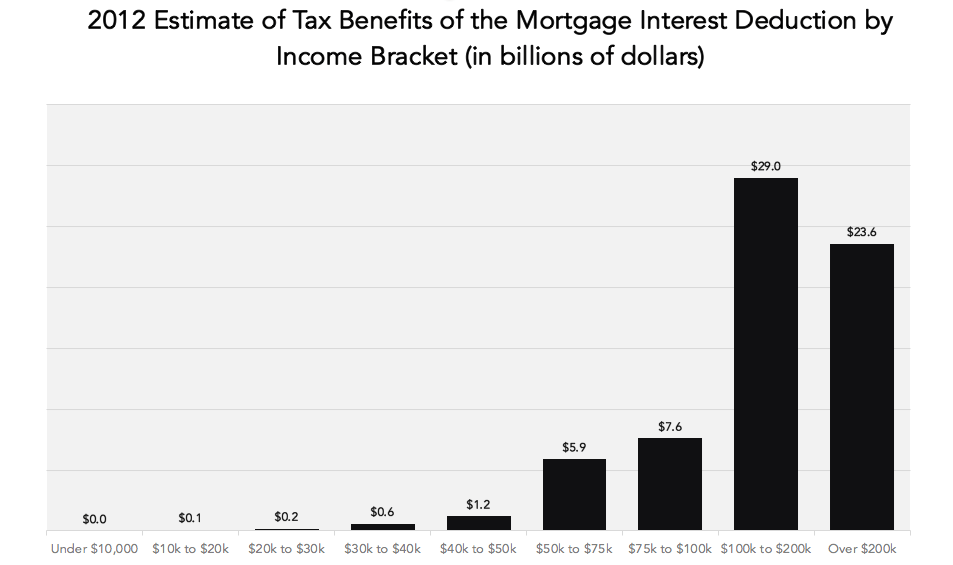
Once upon a time, the federal income tax did not exist.
It first appeared in 1861, born out of a necessity for Civil War funding, and in 1913, Congress made the income tax a permanent part of American life.
The tax code grew over time. But while the government took in more taxes with one hand, it doled out exceptions with the other.
One of the best known tax breaks is the child tax credit, which aims to reduce child poverty by offering tax breaks of up to $1,000 per child. The largest tax break relates to health care: it makes the premiums paid by companies that offer health insurance exempt from payroll taxes. Americans can also reduce their tax bill by installing solar panels, giving to charity, or using their money in innumerable other ways.
All these tax breaks add up to a kind of “shadow budget” that “cost” $1.2 trillion—more than the cost of Medicare and Medicaid.
It may seem odd to think of tax breaks as part of the budget. But for each tax break, the government needs to increase the overall tax rate or issue more debt to “pay” for the tax break and whatever it subsidizes (charitable giving, health care, solar panels). For this reason, organizations like the Congressional Budget Office treat tax breaks and government spending as essentially equivalent.
Like with any government program, the merits of these tax breaks is up for debate. The third largest of these tax breaks—the mortgage interest tax deduction, which, at an annual estimated cost of $77 to $100 billion, allows people to deduct the cost of paying interest on a home loan—is a unique case.
The mortgage interest deduction is popular with the public, and perceived as helping the middle class afford homes. Yet nearly every government official who doesn’t hold elected office, whether Republican, Democrat, or technocrat, believes that the mortgage interest deduction is a terrible policy that does more to subsidize the wealthy’s vacation homes than to help the middle class. It influences how we invest our money and where we live, often in a negative way.
Its existence is also a complete and utter accident—a holdover from the days when most mortgages were for farms.
The Accidental Tax Break
The mortgage interest deduction is now recognized as an important government program that helps more Americans afford homes. In 1984, President Reagan even described the mortgage interest deduction as symbolic of the American dream.
But the deduction began as an unplanned technicality.
When the federal government first levied income taxes in 1913, Congress allowed Americans to deduct from their taxes the cost of all interest payments. This is standard policy for corporations: the government only wants to tax profits—not money spent on loans for tractors or a new office. In 1913, the government allowed deductions on all interest—probably because all interest payments were business-related. No one took out car loans in 1913 or paid interest on credit card debt, and the majority of mortgages were for farms.
In his recounting of the history of the mortgage interest deduction, law professor Dennis Ventry, Jr., notes that Congress did not mention any effort to boost homeownership through the tax code in 1913 or in housing reports published decades later. Nor did Congress view the mortgage interest deduction as a special program.
Through the 1940s, the mortgage interest deduction had a modest impact on America’s finances. But after the Great Depression decimated America’s housing industry, the government created a new Federal Housing Administration to guarantee mortgage payments. This allowed lenders to offer significantly more mortgages at lower rates, and after World War II, this helped returning soldiers move into newly built suburbs, boosting the homeownership rate from 45% to 62%.
This defined postwar American life, including its terrible racial legacy: the Federal Housing Administration excluded minority neighborhoods from the federal guarantees, creating a chasm in wealth and living standards between African-Americans and their white neighbors. Historians refer to this practice as redlining.
The boom in construction and mortgages had another effect: the government realized how much tax revenue it was losing due to the mortgage interest deduction. By the mid to late 1950s, the preferential tax treatment of housing cost the Treasury somewhere between $8 billion and $30 billion in 2016 dollars.
Very few other countries allow taxpayers to deduct the cost of their mortgage payments. Countries including Iceland, Luxembourg, and Switzerland, in fact, tax homeowners for “imputed rent”: the amount of income homeowners would earn if they rented out (rather than lived in) their home.
This is the oddity of the mortgage interest deduction. If you rent a $500,000 apartment, you’ll pay income tax, and then spend some of the money you have left on rent. But if you buy a $500,000 house, every dollar you spend on mortgage interest will reduce your tax bill.
Since the 1950s, government technocrats have advocated that the U.S. reform or eliminate the deduction. It was originally seen as fixing a technicality. But politicians and lobbyists soon created a justification for the mortgage interest deduction: it boosted the homeownership rate by helping the middle class afford homes.
“The tax code properly encourages home ownership through the deduction of mortgage interest,” Congressman Henry Reuss said in 1975. Similarly, a 1973 op-ed described the mortgage interest deduction as a benefit for the “average taxpayer,” and a 1978 poll found that 90% of Americans supported the mortgage interest deduction. As one taxpayer wrote of its appeal, “Every year when I’m doing my taxes and I get to the step in the software where you enter in your mortgage interest, a wave of relief just washes over me.”
The problem is that researchers and administrators nearly unanimously agree that all of this is wrong.
An Upper Class Subsidy
American politicians have a long tradition of trying to boost the homeownership rate in America.
During his presidency, Bill Clinton said that “One of the great successes of the United States in this century has been the partnership forged by the National Government and the private sector to steadily expand the dream of homeownership to all Americans.” President Bush, too, promoted a “homeownership society”.
Economists, technocrats, and political scientists, however, feel ambivalent about this preference for homeownership. Defenders of the tax code point out that homeowners tend to take better care of their property, volunteer at the town library, meet the local congresswoman, and support long-term investments in the community. In short, they take care of the place.
On the other hand, encouraging homeownership creates sprawl and makes workers less likely to move for a better job. And those local, “long-term investments” include resisting racial integration and the construction of new housing that would lower property values. $75 billion is also a lot to pay for people gardening and painting their homes bright colors.
But this argument is not very relevant to the mortgage interest deduction, because the pitch that it helps more people afford homes simply does not check out.
Few countries have a mortgage interest deduction, and yet, a greater or equal share of Australians and Brits own homes than Americans. Moreover, despite fluctuations in the relative value of the deduction, the homeownership rate in America has stayed fixed between 63% and 68% since 1960.
How can a $75 billion subsidy not help people buy homes? Let’s consider the case of a fictional father of two on the cusp of being able to afford a mortgage on a $100,000 home. If he’s making minimum payments at current interest rates, he might pay $3,200 in interest the first year of his mortgage. Since he earns $50,000 a year—and, as a single parent, pays a 15% federal income tax rate—he can deduct $440 from that year’s taxes. (Note: this simplifies the IRS calculation.)
Now consider the case of a father of two who makes $200,000 a year and is buying a million dollar lake house. (Individuals can typically claim the mortgage interest deduction on up to two homes for a tax break worth up to $1.1 million.) Mike pays a 28% federal income tax rate, which means that he can deduct 28% of his $32,200 annual payments. That comes out to $9,020.
A tax break is a really poor way to help people struggling to afford a home, because people with large incomes and major expenses gain the most from tax breaks.

Data from the Joint Committee on Taxation and the Center on Budget and Policy Priorities; chart by Priceonomics
Almost 40% of the Americans who claim the deduction make a six-figure salary or better, and because they buy larger houses and pay higher taxes, they receive over 75% of the benefits of the program. As former IRS commissioner Charles Rossotti once commented, “Why would you want an abnormally large subsidy for people who have abnormally large mortgages?”
One could argue that this isn’t so bad. The $50,000 a year family can still potentially save a few hundred dollars, and it’s not terribly unfair for people who pay high taxes to receive larger tax breaks.
There are a few problems with this line of thinking.
One is that while the deduction does not help more people afford homes, it does incentivize people to invest their money in a larger mortgage—a policy that proved disastrous when the housing bubble burst. There may be no better symbol of the mortgage interest deduction than the endless tracts of foreclosed homes in the suburbs of Las Vegas. They still have not recovered.

The Las Vegas sprawl. Photo credit: ulybug
The other is that everyone involved in selling houses knows that buyers receive tax breaks on their mortgages, which allows them to raise prices. Researchers estimate that lenders and realtors capture a chunk of the subsidy—perhaps 9-17% in the case of mortgage providers. So the tax break offers homebuyers less than they think.
What seems like a tax break for homeowners is better understood as a subsidy for the construction and real estate industry. Which is why they’ve successfully defended the mortgage interest deduction for decades.
The American Dream, by Tax Break
Since the 1950s, reformers have suggested eliminating tax breaks like the mortgage interest deduction and using the savings to lower everyone’s tax rates. It sounds great: a fairer tax code and tax cuts!
The problem, of course, is once you suggest specific changes, the people who benefit defend their interests. In 2012, Alex Blumberg, then of NPR, asked a former lobbyist for the realtor association what he would do if Congress considered ending the mortgage interest deduction.
“I would declare war,” he responded. The lobbyists would run ads, encourage America’s million realtors to make phone calls, and ask members of Congress on the relevant committees—for whom the lobby regularly holds fundraisers—“Do you really want to go down this path? That’s just not a really smart way to run for re-election.”
The biggest weapon of interest groups like realtors and the construction industry, however, is their talking points: that removing the reduction would cause a housing-driven recession and be a tax hike on the middle class. The public largely believes that the deduction is a benefit for the middle class, and polls typically find that a majority of Americans support the mortgage interest deduction.
In 2005, Jeffrey Kupfer was on the receiving end of this rhetoric. President Bush had appointed him as the Executive Director of a bipartisan panel charged with suggesting reforms to the tax code. The panel did not recommend killing the mortgage deduction—President Bush had a policy of increasing homeownership. But they did recommend changes.
Kupfer says they were all aware that they’d face pushback—and they experienced it when they received public feedback and when they ran into colleagues and lobbyists in Washington. When they released the report, Kupfer recalls doing a television interview and being followed by a member of a real estate or construction association who “blasted away that what we’d do would be terrible for the economy.”
The rest of the industry mobilized to make similar comments. Donald Trump helpfully chimed in to say that changing the deduction “will lead to a major recession, if not a depression.”
It didn’t matter that the panel’s recommendations addressed all the usual criticisms: They suggested replacing the tax break with a credit whose value would be 15% of interest payments for all homeowners and capped based on the average home price in the region. That meant the mortgage deduction would target middle class homeowners more effectively.
But the subtler argument is usually the losing argument. Nancy Pelosi, for example, called the mortgage interest deduction “untouchable.”
Whether due to the bruising politics of the deduction, or due to Katrina and the Iraq War occupying the president, Bush did not pursue his panel’s recommendations. The mortgage interest deduction lived on.

Photo credit: Jeff Turner
But it’s not just special interests that keep the mortgage interest deduction alive. It’s that politicians view it differently from the experts.
Tax code reformers point out that many politicians understand that the deduction is perceived as helping the middle class—and that it does help a bit by supporting the construction industry and giving some money to non-wealthy families. Politicians love showing support for the middle class.
Moreover, while economists might argue that a nation of renters is more efficient than a nation of homeowners, politicians know that the way people feel about owning a house has nothing to do with economic efficiency.
Bill Clinton described homeownership as “about more than money and sticks and boards and windows.” George W. Bush made helping people afford a home a key element of his “compassionate conservatism.”
Among policy wonks, there is a bipartisan consensus that the mortgage interest deduction is a horribly unfair and inefficient tax break that subsidizes the wealthy and distorts the economy. But for many politicians, there is a bipartisan sense that the appeal of owning a home is too powerful to do anything about it.
Our next article explores the efforts of two brothers to corner the silver market in 1980. To get notified when we post it → join our email list.
This article was updated on August 4, 2016, to include the comments of Jeffrey Kupfer.
![]()
Note: If you’re a company that wants to work with Priceonomics to turn your data into great stories, learn more about the Priceonomics Data Studio.




